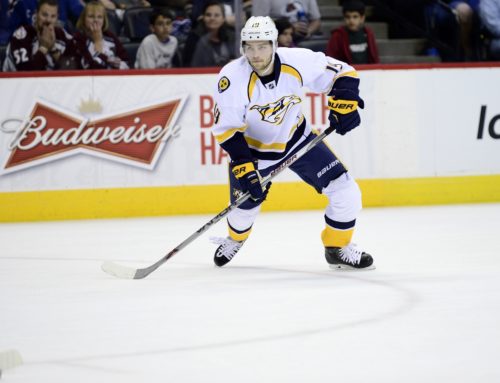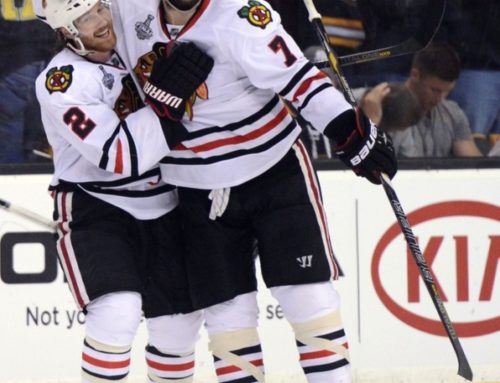
In the Vancouver 2010 Olympics, Team Canada established themselves as the greatest team on earth when they took home gold. They did it with a forward lineup that featured seven natural centremen among its 13 skaters, and another two who've been known to play the middle from time to time. Elite NHL pivots like Eric Staal, Mike Richards and Jonathan Toews found themselves stationed on the wing more often than not.
If it’s good enough for the best team in the world, shouldn’t it be good enough for your fantasy league?
In previous columns, I’ve made a big deal about how I always aim for realism in my league settings. But I’m not too proud to stand before you today and admit that when it comes to positional designations among forwards, I’m a big fat hypocrite.
Unlike many of you (I suspect), I prefer to designate attackers as simply forwards, rather than dividing them into centres, left and right wingers. Yes, this flies in the face of my fixation on realism – and yes, I fully expect some of you to tell me I’m wrong (I welcome any and all attempts to convince me). But here’s why you’ll find my leagues flush with F’s, with nary a C, LW or RW to be found.
1. Everybody Gets a Better Team
It’s well established that the pool of fantasy-worthy centremen is significantly deeper than the selection of wingers. It follows, then, that in a typical 12-team league where teams are required to dress equal numbers of C/LW/RW, some higher quality centres are left undrafted in favour of lower-producing wingers, which are needed to ice a full lineup. Maybe it’s just me, but I’d rather see the best available players get picked, with all teams getting strengthened as a result.
This factor can be mitigated by designating some flex forward spots (for example, lineups could consist of 2C, 2LW, 2RW and 3 forwards of any position). But if you’re doing that, you’re already compromising the centre/winger designations, so why not just do away with them completely?
2. The Injury Factor
Another drawback that I’ve found when forwards are broken down by position is that the impact of injuries is amplified. Let’s suppose your lineup consists of three of each forward position, and you’ve got one of each on your bench. It only takes two injuries at any given position to potentially cripple your team. (The league's transaction limit will determine how easy or difficult it is to fill that hole; we’ll look at that in a future article.) In a forward-only league, conversely, a pair of injuries wouldn’t be nearly so punishing, as you’ve still got a healthy player on your bench.
Two of my current teams are a case in point. In Dobber’s pro league, I suffered early season injuries to centres Jeff Carter, Andy McDonald and Tim Connolly (okay, that last one was my own damn fault). It forced me to burn some of my limited transactions early in the season in a desperate attempt to plug the hole. By contrast, in my keeper league, I’ve also had multiple centres injured simultaneously (first Carter and Ryan Kesler; later Carter and Danny Briere), but because there are no C/LW/RW distinctions, the depth of my forward bench has allowed me to skate through it relatively unscathed.
3. Stimulating Trade Action
If you like a lot of player movement in your league, I’ve found that there tend to be more trades when all forwards are treated the same. If you’re worried about keeping the right balance of centres and wingers, it limits your trade options. You may not want to trade a left winger for a right winger, because it will throw your roster out of balance. To make a trade, you've got to find a deal that's not only fair in terms of fantasy value, but also a good fit positionally.
By contrast, in a league in which all forwards are created equal, it's much easier to find a trade match. More trades makes for a more interesting league, especially as the season passes the midway point and some teams start to fall out of contention.
4. Positional Fluidity
Positions aren’t set in stone. As a Canucks fan, I’ve watched Cody Hodgson and Manny Malhotra line up at centre and on the wing at various times this season. I’ve seen Jannik Hansen on either wing. I’ve cheered on a power play that regularly features a centreman on the wing and a winger on the point. The lesson: just because a player is officially listed as a centre or winger doesn’t mean that’s how he’s always deployed.
A lot of words have been spilled in the forums here at Dobber Hockey over the issue of positional eligibility. In past years, questions like “why doesn’t Malkin/Zetterberg/Marleau have winger eligibility when he’s played most of the year on the wing?” have frequently cropped up, as fantasy sites were slow to add dual eligibility for players who regularly lined up in more than one position. Dual eligibility players were rare and golden, with fantasy managers scrambling to snap up these valued contributors.
This season, Yahoo! evidently decided to listen to the complaints and did a complete 180, granting dual eligibility to everyone and their dog. Just days before the puck dropped on the season, no less than five of my Dobber pro players were given generous new designations, meaning that 7 of the 16 forwards on my current roster are now able to be slotted in at either centre or wing. Given the rules of the league, I’m thrilled to have the flexibility. But isn’t the point of having a set number at each position kind of made moot when half my team can be played in the middle or on the wing? Better to just go all the way, I say. Call them all forwards and leave it at that.
So, what say you? Am I out to lunch on this issue? If so, let me have it in the comments!





 CHI
CHI SEA
SEA FLA
FLA DAL
DAL WPG
WPG CBJ
CBJ L.A
L.A MIN
MIN DET
DET VAN
VAN PIT
PIT
